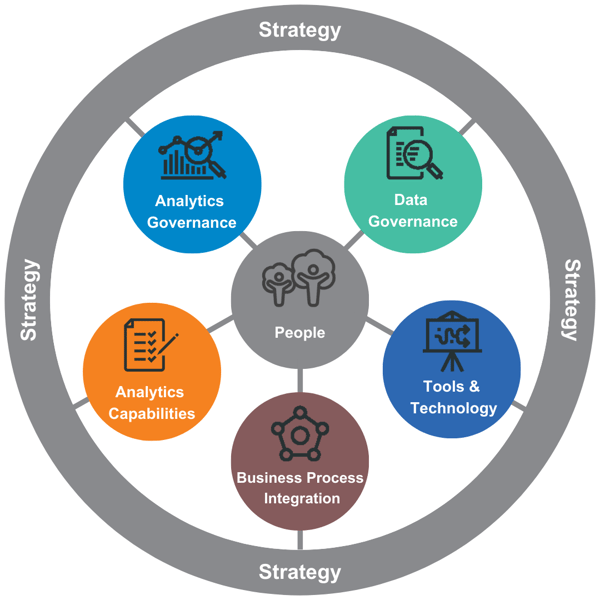
August 14, 2019
Common Gaps that Prevent Utilities from Building an Analytics-Driven Organization - A Blog Series

Bill Wood
Program Manager, Delivery Excellence
If your utility is planning, implementing or improving analytics initiatives within the next twelve months, you need to read this series of blogs.
For utilities, successful analytics initiatives can empower decision makers with data-driven insights and actionable information, but poorly focused initiatives can waste time and effort by working in areas that yield less-than-stellar results. The best way for utilities to guard against unproductive analytics initiatives is to know (and to properly use) the Seven (7) Dimensions of Analytics Maturity as defined by the Utility Analytics Institute (UAI).
Today’s blog establishes the foundation for a 7-part series that links together the 7 dimensions of the UAI’s framework with Utegration’s broad industry experience in order to assist utility organizations striving for digital transformation. Today’s installment is a little longer than most because it is provided background and is intended to be used as a reference guide for upcoming blogs.
Throughout the series, we will identify common gaps, pitfalls and challenges which can prevent utility organizations from implementing successful analytics programs and which may hamper their progress toward the goal of becoming analytics-driven organizations. In each case, we will offer Utegration’s insights into causes, cures, and opportunities based on our collected experiences across the utilities industry. To do so, we will be leveraging experiences and lessons learned from my Utegration colleagues in their present and previous engagements. Sometimes I may feature a colleague as a coauthor. This way readers can be confident they are receiving the full benefit of our team’s broad-based experience.
Background
For almost half a decade, the Utility Analytics Institute (UAI) has been gathering and analyzing data to help member utilities assess the maturity of their analytics initiatives. Under the guidance of their Executive Advisory Committee, the UAI has developed a sophisticated collection of measures that span 7 dimensions to assess analytics maturity. Meanwhile, for more than a decade, Utegration has amassed deep industry knowledge while working closely with utilities across the continental US, Canada and Hawaii to enhance their ERP systems with an ever-increasing portfolio of boutique products and services specifically for the utilities industry.
First Things First
First of all, let’s lay some groundwork. Consider today’s post as installment 0 of 7. As I mentioned earlier, it will become a point of reference for future blogs. Here, we provide necessary context by reviewing the UAI Analytics Maturity Model and discussing the Dimensional Framework used for maturity assessments. We also explain why this particular framework is preferred over all others when working in the utilities industry. As the series progresses, it will become apparent how Utegration uses this framework as a guide to help client utilities better leverage existing resources while continuing to mature the capabilities they need today and build the capabilities they will need in the future.
The UAI Dimensional Framework
The dimensions recognized by the UAI assessment are presented below with some informational bullet points. Awareness of these dimensions can be very helpful in two regards. First, they can help an observer quickly get a sense of the current state of analytics maturity within an organization. Second, and more importantly, they can provide a framework to guide detailed action plans and focus efforts in specific areas that will result in measurable improvements in analytics maturity. This is where the proper application of lessons from experience becomes highly important. The diagram below is Utegration's representation of UAI's dimensional framework.

Strategy
- How is data treated and managed as a corporate asset?
- Degree of strategic development around analytics, and alignment of strategy with corporate vision/mission.
- Analytics drivers – revenue, cost reduction, regulatory, environmental, entrepreneurial.
People
- Organizational model – extent and effectiveness of how the analytics organization planned and managed. Includes level of investment and planning, including top-down support and buy-in.
- Analytics resources – acquisition, training, and retention of skilled analytics professionals.
- Data Driven – the degree to which different business units utilize data and analytics now and are anticipated to use data and analytics within the next three years.
Analytics Governance
- Analytics Governance is the ongoing process of creating and managing analytics processes, policies, and information for the purpose of acceleration business outcomes. This includes strategies, processes, policies, activities, skills/institutional knowledge, information, models, organizations, and technologies.
Data Governance
- Data governance is defined as the overall management of the availability, usability, integrity and security of data used in an enterprise, and includes metadata management.
- Does the organization have a formalized program/strategy, and the degree to which it is enforceable and traceable across the enterprise.
Business Process Integration
- The degree to which data and analytics are integrated into the development and measurement of business KPIs, and the degree of access that employees have to analytic tools and data.
Analytics Capabilities
- Technical capabilities of business units across the utility, from basic reporting to optimization.
Technology & Tools
- Degree to which data management and analytics tools are integrated and managed into the IT infrastructure at the utility, and access to technologies is managed and documented.
Why This Dimensional Framework is Best for Utilities
Utegration finds many things about this framework are appealing when compared to alternatives.
First and foremost, the UAI dimensional framework is credible. Having its roots in the UAI Executive Advisory Council means this dimensional framework was created by utility industry experts for utility industry practitioners. Notably, it was not adapted by management consultants selling cookie cutter consulting services across multiple industries, nor was it concocted by technology vendors marketing a pre-developed product. At best—and regardless of how pure the intentions of the creators might have been—any framework arising from these sources could be perceived to be vulnerable to some level of bias. At worst, they could be intentionally self-serving.
Moreover, it is complete, balanced and comprehensive. We believe it does a good job of covering the waterfront of major issues that will inevitably confront utility organizations on a journey leading to digital transformation. If we did not believe this were the case, we could have (and would have) adopted (or created) a better alternative.
Finally, this dimensional framework lends itself well to helpful metaphors and graphical representations that can be created to emphasize relationships and couplings between and among the dimensions that are tailored specific to a given set of circumstances and goals. As an example, consider the graphic above (our creation, not the work of the UAI.) In this case, the figure shows a diagram representing a loose hierarchy and some logical couplings that were found to be relevant in a particular organization’s circumstances. We believe that tailored depictions such as this can be important aides to understanding when developing thoughtful action plans to align tactical activities with strategic goals while maintaining compatibility with the framework as defined by the UAI.
Our Base Camp is Set
Now the necessary groundwork in place. Let’s get going. To fully explore the 7 dimensions, we will publish a new blog every few weeks with a focusing mainly in one of these dimensional areas. As previously mentioned, we will identify one or more common gaps as observed by Utegration in the field. We will share ideas for potential remedies based on our experience, always with the awareness that unique situations may require specialized adaptation.
A Final Point…One Size does not Fit All
Before concluding, it is important to point out that each set of circumstances is unique. It is not possible within the context of a blog to consider all the factors involved in the universe of ongoing implementations and initiatives. If you would be interested in having Utegration take a close and thoughtful look at your organization’s unique circumstances, please reach out to the author or any of my Utegration colleagues for a no-obligation conversation.
And remember, the best way to stay informed is to follow Utegration on LinkedIn or Twitter, and to subscribe to our blog. You can also follow me on @UtilityBill_101.
